Accepted Scientific Name: Mammillaria elongata DC.
Mém. Mus. Hist. Nat. 17: 109. 1828
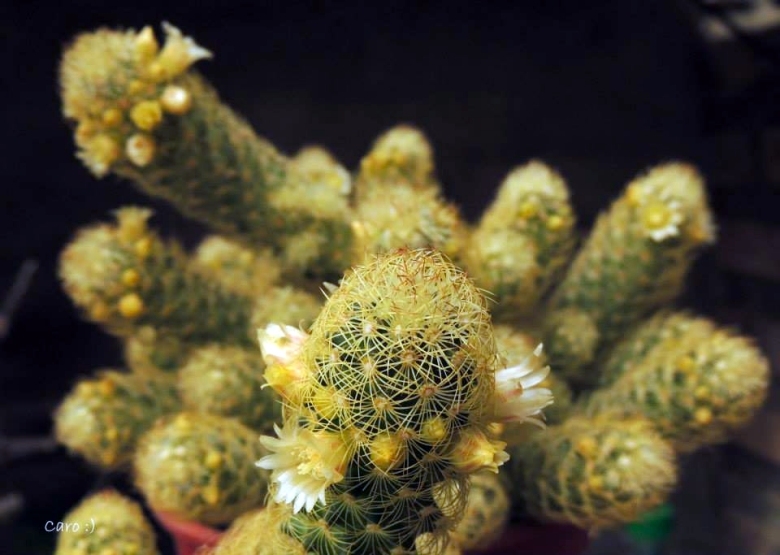
Leptocladia elongata (Mammillaria elongata) Photo by: Carolina González
Origin and Habitat: Mammillaria elongata is endemic to Mexico, where it is distributed in the states of Guanajuato, Hidalgo and Querétaro.
Altitude range: This species grows at about 1,300 to 2,300 metres above sea level.
Habitat and Ecology: This cactus can be found in calcareous soils in matorral. This species is abundant and common over its limited distribution, but mining, land use conversion for agriculture, and habitat degradation due to grazing of goats are impacting some subpopulations of this species.
Synonyms:
See all synonyms of Mammillaria elongata
Common Names include:
ENGLISH: Lady Fingers, Golden Stars
Description: Mammillaria microheliaSN|28215]] is a succulent ground cover, forming with time a tight clumps of erect, ascending, prostrate or recumbent stems. This may be the most common Mammillaria to be found and occurs in more variations than any other Mammillaria species. It commonly comes in many colour and spine variations.
Stems: Elongated cylindrical, finger-like, 1 - 3 cm in diameter 3-10 cm long.
Roots: Fibrous.
Tubercle: Tubercles slender conical arranged in perfect spiral in a few rows. The axil is naked or nearly so.
Areoles: Pubescent when young.
Radial spines: 14 - 25 interlocking, arranged as a star, variable in number, white to golden yellow to brown, the degree of brown colouring varying from plant to plant, slender, needle-like, more or less recurved 4 - 12 mm long.
Central spines: Usually absent, sometimes 2, yellow to brownish, with dark tips, 10 - 15 mm long.
Flower: Small bell shaped to 10 mm long and in diameter at the upper part of the plant. Perianth segments about 12, rather broad, obtuse or sometimes apiculate. whitish, pale yellow or pinkish, sometimes flushed pink or with pink midstripes.
Blooming season: Spring, but can bloom for a second time later in the year.
Fruit: Pink, becoming red.
Seed: Brown.
Remarks: This is a popular species, but many cultivated forms are hybrids, especially with Mammillaria microheliaSN|28215]].
Bibliography: Major references and further lectures.
1) Robert T. Craig “The Mammillaria handbook: with descriptions, illustrations, and key to the species of the genus Mammillaria of the Cactaceae” E P Publishing, 1945
2) John Pilbeam “Mammillaria The Cactus File Handbook” Cirio Pub. Services, 01/Dec/1999Edward Anderson “The Cactus family” Timber Press, Incorporated, 2001
3) James Cullen, Sabina G. Knees, H. Suzanne Cubey "The European Garden Flora Flowering Plants: A Manual for the Identification of Plants Cultivated in Europe, Both Out-of-Doors and Under Glass" Cambridge University Press, 11/Aug/2011
4) David R Hunt; Nigel P Taylor; Graham Charles; International Cactaceae Systematics Group. "The New Cactus Lexicon" dh books, 2006
5) Gómez-Hinostrosa, C., Sánchez , E., Guadalupe Martínez, J. & Bárcenas Luna, R. 2013. Mammillaria elongata. The "IUCN Red List of Threatened Species." Version 2014.2. <www.iucnredlist.org>. Downloaded on 27 July 2014.
6) Ulises Guzmán, Salvador Arias, Patricia Dávila, “Catálogo de cactáceas mexicanas” Universidad Nacional Autónoma de México, Mexico 2003, p.114.
7) Urs Eggli, Leonard E. Newton: “Etymological Dictionary of Succulent Plant Names” Birkhäuser 2004
8) Christopher Brickell “RHS Encyclopedia of Plants and Flowers” Dorling Kindersley Ltd, 01/Sep/2010
9) Haustein, Erik. “Der Kosmos-Kakteenführer.” Kosmos / Gesellschaft der Naturfreunde., Stuttgart, 1983
10) Alfred Byrd Graf “Exotica, series 4 international: pictorial cyclopedia of exotic plants from tropical and near-tropic regions” Roehrs Co. Publishers, 1983
11) Forest & Kim Starr “Mammillaria elongata (Golden stars, lady fingers)”. Plants of Hawaii. <http://www.starrenvironmental.com>. Downloaded on 20 August 2014.
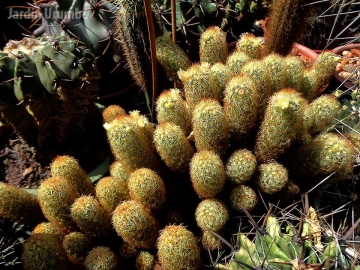 Leptocladia elongata (Mammillaria elongata) Photo by: Alexander Arzberger
Leptocladia elongata (Mammillaria elongata) Photo by: Alexander Arzberger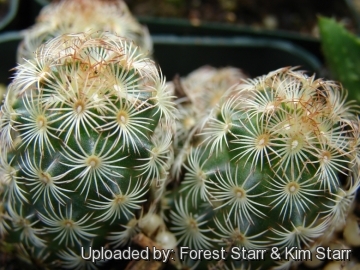 Habit at Kula Ace Hardware and Nursery, Maui, Hawaii (USA). September 06, 2007. (Mammillaria elongata) Photo by: Forest Starr & Kim Starr
Habit at Kula Ace Hardware and Nursery, Maui, Hawaii (USA). September 06, 2007. (Mammillaria elongata) Photo by: Forest Starr & Kim Starr Leptocladia elongata (Mammillaria elongata) Photo by: Carolina González
Leptocladia elongata (Mammillaria elongata) Photo by: Carolina González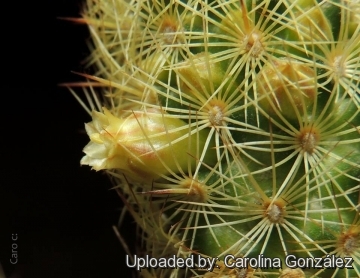 Leptocladia elongata (Mammillaria elongata) Photo by: Carolina González
Leptocladia elongata (Mammillaria elongata) Photo by: Carolina González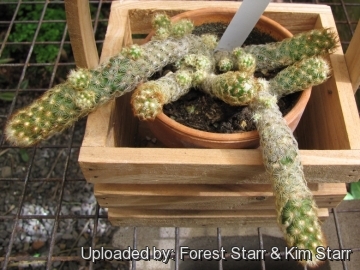 Habit at Sacred Garden of Maliko, Maui, Hawaii (USA). January 24, 2011. (Mammillaria elongata) Photo by: Forest Starr & Kim Starr
Habit at Sacred Garden of Maliko, Maui, Hawaii (USA). January 24, 2011. (Mammillaria elongata) Photo by: Forest Starr & Kim StarrSend a photo of this plant.The gallery now contains thousands of pictures, however it is possible to do even more. We are, of course, seeking photos of species not yet shown in the gallery but not only that, we are also looking for better pictures than those already present.
Read More... Cultivation and Propagation: Mammillaria elongata is a very easy to grow species, just as a classic cactus that don't requires any special treatment, but need as much light as possible without burning the plant to encourage the heaviest spine formation. It is a great plant for the cactus grower, that readily builds up into a cluster of stems highlighted by dense golden spines, further decorated by rings of yellow blooms.
Growth rate: It is a relatively rapid growing species. This is easily grown into clumps, but it does often have an irregular pattern of offsetting. Most plants will offset readily, and clumps can be produced in a few years.
Soils: It likes very porous standard cactus mix soil with little organic matter (peat, humus).
Repotting: Repotting every 2-3A years. As it is prone to rot under-pot in a smaller container filled with very porous compost. Use pot with good drainage.
Watering: Water regularly in summer, but do not overwater (very wet-sensitively). Its roots are easily lost in pots that stay damp for any length of time. Keep dry with ample airflow in winter. In the rest period no high atmospheric humidity!! Care must be taken with watering as they tends to become swollen and untidy in growth habit if given too much water and shade.
Fertilization: During the growing season enrich the soil using a fertilizer rich in potassium and phosphorous, but poor in nitrogen, because this chemical element doesn’t help the development of succulent plants, making them too soft and full of water.
Hardiness: It is quite frost resistant if kept dry, hardy as low as -5° C (some reports give it hardy to -12°C). However some warmth throughout the year will increase the grower's success (minimum 5° to 8°C during rest season).
Exposition: Outside bright sun, filtered sunlight or afternoon shade, inside it needs bright light, and some direct sun. Subject to sunburn if exposed to direct sun for too long. Tends to bronze in strong light, which encourages flowering and heavy spine production.
Uses: It is an excellent plant for container growing. It always looks good and stays small. It look fine in a cold greenhouse and frame.
Traditional uses: The white, hooked spines of this spherical cactus were used as fish hooks in its native Mexico.
Pests & diseases: It may be attractive to a variety of insects, but plants in good condition should be nearly pest-free, particularly if they are grown in a mineral potting-mix, with good exposure and ventilation. Nonetheless, there are several pests to watch for:
- Red spiders: Sensitive to red spider mite. Overhead watering is helpful in controlling mites.
- Mealy bugs: Occasionally mealy bugs they develop aerial into the new growth among the wool with disfiguring results, but the worst types develop underground on the roots and are invisible except by their effects.
- Scales: Scales are rarely a problem.
- Rot: Rot it is only a minor problem with cacti if the plants are watered and “aired” correctly. If they are not, fungicides won't help all that much.
Propagation: By division, or direct sow after last frost. Seeds germinate in 7-14 days at 21-27° C in spring, remove the glass cover gradually as the plants develops and keep ventilated, no full sun for young plants! The seedlings should not be disturbed until they are well rooted, after which they can be planted separately in small pots. Cuttings: wait until the offsets that appear at the base of old clustered specimens are 1/3 the size of the parent and then detach and plant. Cuttings will take root in a minimum temperature of 20° C (but better in hot weather). Cuttings of healthy shoots can be taken in the spring and summer. Cut the stem with a sharp, sterile knife, leave the cutting in a warm, dry place for a week or weeks (depending on how thick the cutting is) until a callus forms over the wound. Once the callus forms, the cutting may be inserted in a container filled with firmed cactus potting mix topped with a surface layer of coarse grit. They should be placed in the coarse grit only; this prevents the cut end from becoming too wet and allows the roots to penetrate the rich compost underneath. The cuttings should root in 2 to 6 weeks.















